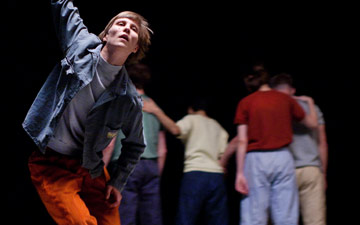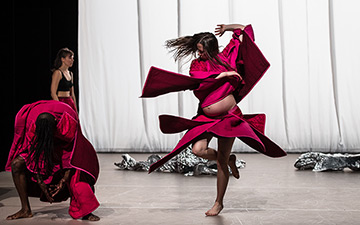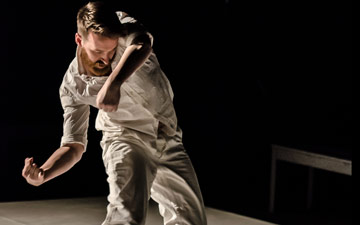
© Pari Naderi. (Click image for larger version)
Theo Clinkard
Accumulation, Ordinary Courage
London, Laban Theatre
28 January 2014
www.theoclinkard.com
www.trinitylaban.ac.uk
Thanks to an Artists International Development Fund award from the Arts Council England, Theo Clinkard spent a week in New York last December, learning the repetitive gestures of Trisha Brown’s seminal work, Accumulation. He worked with Carolyn Lucas of the Trisha Brown Dance Company and former company dancer, Brandi Norton, to rehearse the solo, which Clinkard had already performed back in 2008 as part of the repertoire for Magpie, the show he co-produced with Antonia Grove under the joint name of PROBE.
Accumulation was created by Brown in 1971 and it began a new cycle of her work that expanded to include Accumulation 55’, Primary Accumulation, Accumulation with Talking and Accumulation with Talking Plus Water Motor. It seems from discussions with Clinkard that, while in New York, his research included seeing rare rehearsal footage of Brown performing the longer version in Accumulation 55’, which has introduced new details into his Accumulation solo, slightly varying this interpretation from the version performed by the Trisha Brown Dance Company.
Accumulation is essentially based on gesture, primarily via the hand, beginning with a simple action from the thumb and in the rotation of the fist. In making Accumulation Brown was both posing a series of post-modernist questions about what is acceptable in dance and following through with her career-long obsession about the mechanics of movement (an interest that has also become manifest in her detailed drawings of the hand and body). The layering of simple movement motifs such as dropping the arm, rotating the wrist and stepping back becomes a structured form of dance through its clever interaction with the pulsating music in the recording of Uncle John’s Band by The Grateful Dead.
Brown herself described Accumulation as “very lonely to perform” and there is certainly no room for error and nowhere to hide with the solo dancer placed centrally on a well-lit stage. But Clinkard had absorbed the code well and he performed with alacrity and apparent comfort, masking the necessary intense concentration with an evident sense of fun. It was like watching the body as a means of archival retrieval, summoning up a physical representation of an important work of art. Congratulations are due to Clinkard for so flawlessly delivering this celebrated work – apparently the only man ever to do so – plus a metaphorical bouquet to the Arts Council England for making it all possible.
Accumulation was the substantial hors d’oeuvre for Clinkard’s own new work, Ordinary Courage, performed by a sextet of excellent dancers, including Clinkard himself and the charismatic Canadian dancer and choreographer (and erstwhile assistant to Wayne McGregor), Laila Diallo who has worked with Clinkard before (most memorably in between the shingle and the dune). Diallo started dancing with McGregor’s Random Dance as far back as 1998, a fact that seems impossible given the continuing youthful zest that she brings to the stage.
As well as developing the concept and leading the choreographic process (he also credits his fellow dancers with developing the choreography), Clinkard was responsible for the costume and set design, the key element of which was a grid-like installation of cloth-covered lighting, which, although the choreographer’s concept, was implemented by lighting artist, Zerlina Hughes. It was an effective and atmospheric bonus that gelled well with an ethereal score by Alan Stones (incorporating extracts of Scarlatti and Bach) played live on-stage by the concert pianist, Clíodna Shanahan. Costumes picked out each performer in differing coloured tops and trousers, no two of which were alike so that they looked like a moving colour chart from grey and beige through to purple and orange. Full credit is due for arranging this seamless set of creative collaborations to underpin the choreography and performance with a sensitive and effective ambiance.
Ordinary Courage is a non-narrative work that concerns issues of loss and vulnerability and how they may be overcome by moments of kindness and compassion. “We are defined by how well we rise after falling” is the way the work is defined in the programme. The opening and closing sequences are the most structured in terms of the group dynamic, which included the memorable imagery of the six dancers strung out in a line formation, each one covering the eyes of the dancer in front, and in which there is also a throwback reflection to the significance of gesture in Accumulation, but here with the entire cast ebbing and flowing in harmonious, collective and consecutive movement.
Throughout the long middle section, we encounter dancers dropped from the group, isolated from the central dynamic but there always appears to be a movement or the touch of a colleague to pull them back. Just as the feeling creeps in that this may be the time to shift direction, Clinkard pulls out a remarkably surprising coup de theatre, which I will not spoil by revealing. Suffice to say that it makes his point strongly and simply as well as establishing a visual moment in his sense of theatre that will not be forgotten by anyone who sees it. In years to come, this audience will have scanty memories about this work, including the title, but they will – for sure – remember this one event. It’s a small but significant detail that could have been unnecessarily surreal if handled in the wrong way, but it works sweetly and with the significance of emphasising the central message that we can best communicate by touch and cuddle whenever words are inadequate.
Clinkard’s ability to draw together an integrated theatrical experience that engages bespoke live music and a clever lighting design shows a sure touch of class. Moreover, there is a robust structural integrity in his choreography that makes its point with purpose and vigour and he commands an effective use of time and space in a work that is expertly performed by an excellent ensemble. I was disappointed that there was not a more immediate follow-up by Clinkard to the mixed programme put on by PROBE in 2008 but here it is, at last, with an excellent new work having the added benefit of coming attached to the renovation of a post-modern classic. This was a fascinating and entertaining evening spent beside Deptford Creek and I look forward to the next.

















You must be logged in to post a comment.